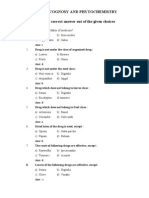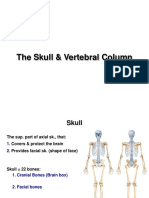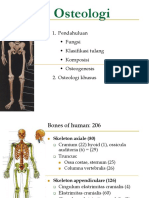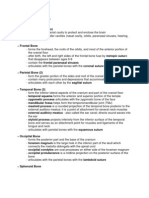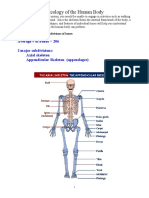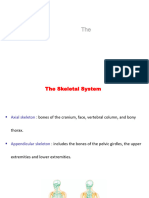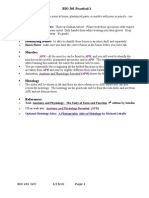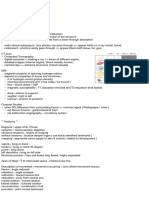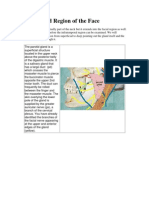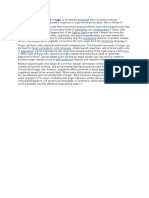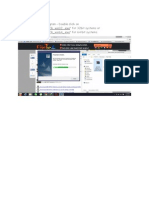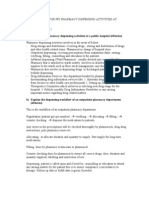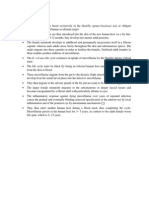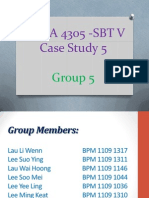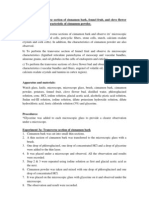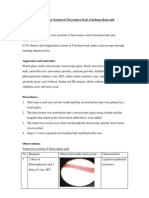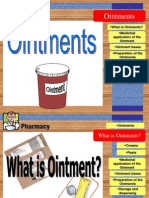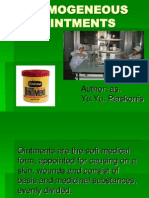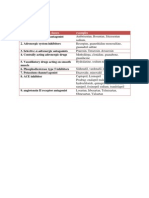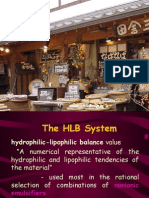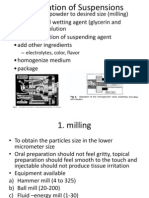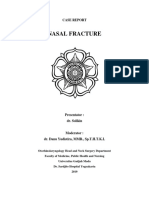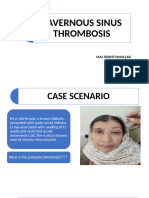Vertebrae To The Skull: Frontonasal Suture
Vertebrae To The Skull: Frontonasal Suture
Uploaded by
Ah BoonCopyright:
Available Formats
Vertebrae To The Skull: Frontonasal Suture
Vertebrae To The Skull: Frontonasal Suture
Uploaded by
Ah BoonOriginal Title
Copyright
Available Formats
Share this document
Did you find this document useful?
Is this content inappropriate?
Copyright:
Available Formats
Vertebrae To The Skull: Frontonasal Suture
Vertebrae To The Skull: Frontonasal Suture
Uploaded by
Ah BoonCopyright:
Available Formats
1.
Axial skeleton (80 bones) -consists of skull, vertebral column and thoracic cavity/cage (costal cartilage, sternum, ribs) a) skull (22 bones) -consists of cranial and facial bones -skull bones are flat except for mandible -adult skull bones are united by sutures. i) cranial bones/ cranium/ neurocranium (8 bones) -function: -protect the brain -attachment for neck and head muscle - entire group of cranial bones is called cranial vault /calvaria -consists of frontal, parietal, occipital, temporal, squamous, ethmoid ii) facial bones / viscerocranium (14 bones) function: -framework of the face -cavity for the special sense organ -opening for food and air - secure the teeth - facial muscle expression -only mandible and vomer are unpaired bone -maxillae, zygomatics, nasals, lacrimals, palatines and inferior nasal conchae are paired bones 2. 8 cranial bone: a) frontal bone (1) -articulate posteriorly with parietal bone via coronal suture. -anterior part is the forehead/ frontal squama -form superior orbit and anterior cranial fossa. -supraorbital notch/ foramen: allow supraorbital artery and nerve to pass to the forehead -glabella: smooth portion between frontal bone and orbit -frontal bones meet the nasal bone at frontonasal suture -frontal sinuses: area lateral to glabella and riddled with sinuses. b) parietal bone (2) -form superior and lateral aspect of the skull (cranial vault) - 4 suture: coronal (frontal &parietal), sagittal ( 2 parietal), lambdoid (parietal &occipital), squamous (parietal & temporal) c) occipital bone (1) join the sphenoid bone via basioccipital that bear pharyngeal tubercle form posterior cranial fossa (support cerebellum) foreman magnum: spinal cord hypoglossal canal: hypoglossal nerve occipital condyle: articulate with atlas (permit a nodding movement of head) external occipital protuberance & nuchal line: neck & back muscle external occipital crest: secure ligamentum nuchae that connect cervical vertebrae to the skull
d) temporal bone (2) - form inferolateral aspects of the skull and part of cranial floor - divide into squamous, tympanic, mastoid, petrous region - squamous region 1) zygomatic process + zygomatic bone = zygomatic arch 2) mandibular fossa + mandibular condyle = temporomandibular joint -tympanic region 1) external acoustic meatus: external ear to eardrum 2) internal acoustic meatus: CN VII, VIII 3)styloid process: tongue & neck muscle, stylohyoid ligaments attached the lesser horns/ cornua of hyoid bone to the styloid process -mastoid region 1) mastoid process: tongue & neck muscle 2) stylomastoid foramen: facial nerve (CN VII) - petrous region (between sphenoid and occipital) 1) carotid canal: carotid artery 2) jugular foramen: jugular vein 3) foramen lacerum 4) middle and internal ear cavities ( receptor for hearing and balance) e) sphenoid bone (1) - keystone of cranium (articulate with all other cranial bone) - consists of central body and 3 processes (greater wing, lesser wing, pterygoid process) - greater wing = middle cranial fossa and dorsal wall of orbit - lesser wing = anterior cranial fossa and medial wall of orbit - pterygoid process =pterygoid muscle (important for chewing) - sella turcica tuberculum sellae hypophyseal canal (pituitary gland/ hypophysis) dorsum sellae posterior clinoid process (secure brain within the skull) - optic canal: ophthalmic nerve - supraorbital fissure: CN that control eye movement (CN III, IV, VI) - foramen rotundum &foremen ovale: CN V - foramen spinosum: meningeal artery f) ethmoid bone (1) bony area between nasal cavity and orbit crista galli: falx cerebri / dural membrane (secure brain in cranial cavity) cribriform plate: olfactory foramina => smell receptor perpendicular plate: divide nasal cavity into right and left halve orbital plate = lateral surface of ethmoid lateral mass that form medial wall of orbit superior & inferior nasal conchae/ turbinate = increase turbulence of air flow
*** Sutural bones = irregular bone appear in the lambdoid suture, represent additional ossification centers when the skull expanding rapidly during fetal development.
3) facial bones (14 bones) a) mandible -coronoid process: insertion point for temporalis muscle (elevate lower jaw during chewing) -mandibular fossa + mandibular condyle = temporomandibular joint -mandibular symphysis: 2 mandibular bones fuses during infancy -mandibular foramen: tooth sensation to the lower jaw -mental foramen: blood vessel & nerve to pass to chin and lower lip b) maxillary bones - keystone of facial skeleton (articulate with all facial bones except mandible) -anterior nasal spine= maxillae meet medially -frontal processes= form lateral aspects of the nose -hard palate = roof of the mouth -incisive fossa = passageway for blood vessels and nerve -maxillae articulate with zygomatic bones via zygomatic processes -inferior orbital fissure= zygomatic nerve, maxillary nerve and vessles to pass to the face -infraorbital foramen =infraorbital nerve and artery to reach the face. c) zygomatic bones = cheek bones d) nasal bones (attach to cartilage that form skeleton of external nose) e) lacrimal bones -form medial wall of orbit -contain lacrimal fossa (deep groove) that houses lacrimal sac => allow tears to drain from the eye surface to the nasal cavity. f) palatine bones -2 bony plate:
horizontal plate (posterior hard palate) perpendicular plate (posterolateral walls of nasal cavity and orbit) - 3 articular process ( pyramidal, sphenoidal, and orbital) f) vomer form the nasal septum g) inferior nasal conchae form lateral wall of nasal cavity ( the largest of the conchae)
4. orbit -eyes encased and cushioned by fatty acid -contain muscle that control the eye movement and tear producing lacrimal gland - form by 7 part of bones a) roof : sphenoid lesser wing + orbital plate of frontal bone b) medial wall: sphenoid body + ethmoid orbital plate + maxilla frontal process + lacrimal bone c) lateral wall: sphenoid greater wing + zygomatic process of frontal bone + orbital surface of zygomatic bone d) floor : palatine orbital process+ maxillae orbital surface +zygomatic bone
Movement occur between vertebrae are 1) flexion and extension (anterior/ posterior straightening of spine) 2) lateral flexion (bending upper body to the right/ left) 3) rotation Characterist Cervical ic 1.body Small (wide side to side) 2.spinous process 3.vertebral foramen Short, project posteriorly (bifid ) except C7 Triangular Thoracic Medium (Heart shape, 2 costal facet) Long, project inferiorly (sharp) Circular Lumbar Massive (Kidney shape) =>resist most stress Short, project posteriorly (blunt) Triangular
4. transverse processes 5. superior articulate process 6. inferior articulate process 7. movement allowed
Contain transverse foramen
Bear facet for rib (except T11 &T12)
Thin and tapered
Superior facet directed Superior facet directed superoposteriorly posteriorly Inferior facet directed inferoanteriorly Inferior facet directed anteriorly i) lateral flexion limited by ribs ii) rotation * no flexion and extension
Superior facet directed medially Inferior facet directed laterally i) flexion and extension ii) lateral flexion *no rotation
i) Flexion and extension ii) lateral flexion iii) rotation (it has the greatest range of movement) Sternum/ breastbone -anterior midline of the thorax --fusion of 3 bones
a) manubrium: articulates with clavicles (via clavicular notches) ,1st , 2nd pair of ribs b) body: articulate with cartilages of 2nd to 7th ribs c) xiphoid process: articulate only with sternal body (attachment point for abdominal muscles) -3 important landmarks a) jugular notch: central indentation() in superior border of the manubrium b) sternal angle: horizontal ridge between manubrium and sternal body function: i) allow the sternal body to swing forward when inhale. ii) reference point for finding 2nd ribs in physical examination iii) listen to sounds made by specific heart valves. c) xiphisternal joint: a point where sternal body and xiphoid process fuse. ( 9th TV)
Appendicular skeleton : coronoid process = temporalis muscle (mandible) conoid tubercles =clavicle posterior end coracoid process (scapula)=>stabilize the joint acromion (scapula) glenoid cavity (scapula)=> shoulder joint 1. Appendicular skeleton is the bones of limbs and their girdle that appended to the axial skeleton, forming the longitudinal axis of the body. 2. pectoral girdle (shoulder girdle) -consists of clavicle and scapula - scapula attached to the thorax and vertebral column by muscles - light and allow upper limbs a degree of mobility because a) scapula can move freely across the thorax (only clavicle attach to axial skeleton) b) glenoid cavity (shoulder joint socket) is shallow and does not restrict the movement of humerus 3. clavicle/ collarbone extend horizontally across the superior thorax sternal end(cone-shaped) attached to manubrium of sternum acromial end (flat) attached to the acromion of scapula = acromioclavicular joint superior end is smooth inferior end is ridged and grooved by ligament and muscle (eg. Conoid tubercle) function ii) act as a brace (hold scapula and arm laterally)
i) anchor muscle and ligament
iii)transmit compression force from upper limbs to the axial skeleton 4. scapula -triangular flat bone -each scapula has 3 border superior = shortest medial/ vertebral =parallel to vertebral column inferior/ axillary = armpit - each scapula has 3 angles/ corners
superior angle: superior + medial border lateral angle: superior + lateral border inferior: medial + lateral border - anterior surface is concave and featureless -posterior surface bears a spine that end laterally into acromion -coracoid process anchor the biceps muscles of the arm -supraorbital notch is a nerve passage -suprapinous fossa and infraspinous fossa are superior and inferior to the spine respectively -subspinous fossa formed the entire anterior scapular surface 5. upper limb/ arm/ humerus -arm =between shoulder and elbow -articulates with scapula (head fits into glenoid cavity) ; radius and ulna (forearm bones)at elbow -greater tubercle and lesser tubercle (attachment for rotator cuff muscles) are separated by intertubercular sulcus/ bicipital groove (guide biceps tendon to its attachment point at glenoid cavity) - anatomical neck and surgical neck (most frequently fracture part of humerus) -deltoid tuberosity <=> deltoid muscle of shoulder -radial groove <=> radial nerve -2 condyles at distal end a) trochlea (medial) =ulna ( form the elbow joint with humerus) b) capitulum (lateral) =radius (carries the hand) -medial and lateral epicondyles = muscle attachment site - ulnar nerve, run behind medial epicondyle responsible for painful, tingling sensation when hit the funny bone -coronoid fossa and olecranon fossa( trochlea ) allow ulna to move freely when the elbow is flexed and extended. -radial fossa receives radius head when the elbow is flexed.
Carpal (wrist) Proximal row: scaphoid(lateral), lunate, triquetrum, pisiform(medial) Rmb key: She look too pretty Distal row: trapezium(lateral), trapezoid, capitate, harnate(medial) Rmb key: Try to catch her -scaphoid bone is a small carpal bone on the thumb side (radial side) of the wrist. It is the most commonly fractured carpal bone.This is probably because it actually crosses two rows of carpal bones, forming a hinge.
12 pair of cranial nerve: Oh = olfactory Oh = optic Oh = occulomotor They = trochlear Traveled = trigeminal And =abducens Found = facial Voldermort = vestibulocochlear Guarding = glossopharyngeal Very = vagus Ancient/secret = accessory (spinal) Horcruxes =hypoglossol
Oh oh oh , they touch and feel virgin girl vagina and high Some say marry money but my brother says big brains matter more S= sensory m= motor b= both
You might also like
- Quiz - Special SensesDocument4 pagesQuiz - Special SensesGlydenne Glaire Poncardas Gayam100% (2)
- Unit VIIIa Lecture NotesDocument5 pagesUnit VIIIa Lecture NotesSteve Sullivan100% (1)
- MCQ in Pharmacognosy and PhytochemistryDocument42 pagesMCQ in Pharmacognosy and PhytochemistryHarish Kakrani84% (195)
- Redox TitrationDocument4 pagesRedox TitrationAh BoonNo ratings yet
- Head Neck Assesment and Technique of Physical AssesmentDocument4 pagesHead Neck Assesment and Technique of Physical AssesmentFitriani PratiwiNo ratings yet
- The Skull & Vertebral ColumnDocument41 pagesThe Skull & Vertebral ColumnBadria Al-najiNo ratings yet
- Specific Osteology: Skeleton Axiale - Cranium (Skull) - Truncus (Trunk)Document46 pagesSpecific Osteology: Skeleton Axiale - Cranium (Skull) - Truncus (Trunk)Defi Sofianti AnnoNo ratings yet
- The Skeleton: Chapter 7 - Part ADocument7 pagesThe Skeleton: Chapter 7 - Part AJonathan HigginbothamNo ratings yet
- Unit VIIIb Lecture NotesDocument4 pagesUnit VIIIb Lecture NotesSteve Sullivan100% (1)
- The Skeleton: Dr. Ali EbneshahidiDocument64 pagesThe Skeleton: Dr. Ali EbneshahidiMarcus Randielle FloresNo ratings yet
- Axial SkeletonDocument69 pagesAxial SkeletonKharisulNo ratings yet
- 2ND Grading Laboratory SheetsDocument16 pages2ND Grading Laboratory SheetsAllecia Leona Arceta SoNo ratings yet
- Anatomy Bones UL 2022Document33 pagesAnatomy Bones UL 2022lailahamdy2004No ratings yet
- Anatomy (Marian Diamond)Document34 pagesAnatomy (Marian Diamond)NHZANo ratings yet
- The-Skull by Dr. Phan SandethDocument65 pagesThe-Skull by Dr. Phan SandethTith Sunny100% (2)
- Bio 201 - Bone Practical Part 1 (Axial Skeleton)Document5 pagesBio 201 - Bone Practical Part 1 (Axial Skeleton)Gretchen100% (1)
- Chapter 6 Reading NotesDocument6 pagesChapter 6 Reading NotesJohnny Venomlust100% (1)
- Osteology of The Human BodyDocument17 pagesOsteology of The Human BodyAyuba EmmanuelNo ratings yet
- The Endoskeleton of Birds.Document29 pagesThe Endoskeleton of Birds.Ian LasarianoNo ratings yet
- Axial Skeletal System lect 2 (1)Document95 pagesAxial Skeletal System lect 2 (1)gazisultanamrNo ratings yet
- Anatomy - Upper Limb: 1) ClavicleDocument4 pagesAnatomy - Upper Limb: 1) ClavicleJasmine TeoNo ratings yet
- Skull-Structure and FunctionsDocument33 pagesSkull-Structure and FunctionsMorris KariukiNo ratings yet
- Radius and Ulna: PPP Jazlan Bin Mohamad (Posbasic Ortho 1/2018)Document17 pagesRadius and Ulna: PPP Jazlan Bin Mohamad (Posbasic Ortho 1/2018)Jazlan MohamadNo ratings yet
- Lab Manual Anatomy-1Document48 pagesLab Manual Anatomy-1Vandana BhartiNo ratings yet
- The Axial Skeleton - 2Document158 pagesThe Axial Skeleton - 2Zaid HamdanNo ratings yet
- SkullBonesPages1 4 PDFDocument122 pagesSkullBonesPages1 4 PDFJennifer FirestoneNo ratings yet
- BIO 201 Practical 1 ListDocument9 pagesBIO 201 Practical 1 Listjlette453185No ratings yet
- Tempro-Mandibular Joint: - Can Be Classified Anatomically and Functionally A-AnatomicallyDocument25 pagesTempro-Mandibular Joint: - Can Be Classified Anatomically and Functionally A-AnatomicallySamwel Emad100% (1)
- 2nd Grading Activity SheetsDocument22 pages2nd Grading Activity SheetsXella RiegoNo ratings yet
- Skull As A Whole: The Ventral Surface of The SkullDocument10 pagesSkull As A Whole: The Ventral Surface of The SkullMiss BooksNo ratings yet
- Anatomy of SkullDocument58 pagesAnatomy of Skullamenaa.elNo ratings yet
- MSK Summary 2Document36 pagesMSK Summary 2Seung Chan YooNo ratings yet
- Anatomy ReviewDocument8 pagesAnatomy ReviewbeanNo ratings yet
- H+N AnatomyDocument6 pagesH+N AnatomyNikita ShokurNo ratings yet
- (F5) The Axial SkeletonDocument14 pages(F5) The Axial SkeletonTaima AwamlehNo ratings yet
- Parotid Gland ViiiiiiiiiipDocument9 pagesParotid Gland ViiiiiiiiiipHassan TamerNo ratings yet
- Head and Neck Dr. Wahdan - @medicine - Way2Document355 pagesHead and Neck Dr. Wahdan - @medicine - Way2Joubert ViannaNo ratings yet
- Bones of The H&NDocument12 pagesBones of The H&Naminshafihassan902No ratings yet
- ანატომია ზეპირიDocument22 pagesანატომია ზეპირიmaNo ratings yet
- Anatomy 4 Scalp BonesDocument3 pagesAnatomy 4 Scalp BoneszahraaNo ratings yet
- Anat NotesDocument94 pagesAnat NotesCarineHugz (CarineHugz)No ratings yet
- 03 Unit 2008Document88 pages03 Unit 2008sbouch950No ratings yet
- 2 - Shoulder Girdle PDFDocument38 pages2 - Shoulder Girdle PDFMayra FlorNo ratings yet
- LAB Notes: Bone Tissue (Osseous Tissue)Document10 pagesLAB Notes: Bone Tissue (Osseous Tissue)Erica ObrienNo ratings yet
- 1 by ShurokDocument9 pages1 by ShurokabdulalemalnsefNo ratings yet
- Lesson 3Document25 pagesLesson 3zohebqaiser02No ratings yet
- Thoracic ESDocument237 pagesThoracic ESAbel Belete100% (1)
- Module 5.2 The Skeletal System Part 2Document55 pagesModule 5.2 The Skeletal System Part 2Christian MedallaNo ratings yet
- Bones of The Skull Author Department of Oral and Maxillofacial SurgeryDocument17 pagesBones of The Skull Author Department of Oral and Maxillofacial Surgeryمدونة الأحترافNo ratings yet
- HeadDocument22 pagesHeadahmdalhthrh10No ratings yet
- Head and Neck IntroDocument10 pagesHead and Neck Introekanayakahashini18No ratings yet
- Lecture 4 Human Anatomy Dr. Mohammed WasnanDocument12 pagesLecture 4 Human Anatomy Dr. Mohammed Wasnanspo9equtabaNo ratings yet
- #5 Axial and Appenicular Skeleton NotesDocument11 pages#5 Axial and Appenicular Skeleton Notesshouryamishra038No ratings yet
- Skeletal System NotesDocument5 pagesSkeletal System NotessureshNo ratings yet
- Kartu Hapalan Osteology Anatomy 2018: Nama: .. NIM: .. PembimbingDocument8 pagesKartu Hapalan Osteology Anatomy 2018: Nama: .. NIM: .. PembimbingzannubanabilahNo ratings yet
- Exam Answers Topanat-convertedDocument172 pagesExam Answers Topanat-convertedPrateeksha RaoNo ratings yet
- Skeletal SystemDocument17 pagesSkeletal SystemDEVNo ratings yet
- HeadDocument56 pagesHeadPiniel MatewosNo ratings yet
- Retroperit. Pelvis & Perineum - PPT - Compatibility ModeDocument185 pagesRetroperit. Pelvis & Perineum - PPT - Compatibility ModeMignot Aniley100% (1)
- Anatomy BonesDocument11 pagesAnatomy BonesDunkin DonutNo ratings yet
- The Skeletal SystemDocument8 pagesThe Skeletal Systemelmos3adNo ratings yet
- Week 4Document138 pagesWeek 4Anne nicole P. CasemNo ratings yet
- Emotional: Anger, Also Known As Wrath orDocument1 pageEmotional: Anger, Also Known As Wrath orAh BoonNo ratings yet
- LofralDocument10 pagesLofralAh BoonNo ratings yet
- Step 1Document6 pagesStep 1Ah BoonNo ratings yet
- Answer Schemes For Pp3 Pharmacy DispensingDocument2 pagesAnswer Schemes For Pp3 Pharmacy DispensingAh BoonNo ratings yet
- Blood Pressure Monitors ReviewDocument14 pagesBlood Pressure Monitors ReviewAh BoonNo ratings yet
- Pathogen Es IsDocument5 pagesPathogen Es IsAh BoonNo ratings yet
- Narcolepsy and CataplexyDocument6 pagesNarcolepsy and CataplexyAh BoonNo ratings yet
- Practical 2Document6 pagesPractical 2Ah BoonNo ratings yet
- Case Study - Group 5-Sem 4Document36 pagesCase Study - Group 5-Sem 4Ah BoonNo ratings yet
- Practical 3Document6 pagesPractical 3Ah Boon100% (2)
- Practical 1Document6 pagesPractical 1Ah BoonNo ratings yet
- OintmentsDocument29 pagesOintmentsAh BoonNo ratings yet
- Pharmaceutical Suppositories & PessariesDocument34 pagesPharmaceutical Suppositories & PessariesAh Boon100% (1)
- Homogeneous OintmentsDocument25 pagesHomogeneous OintmentsAh BoonNo ratings yet
- Epidemiology Study DesignsDocument16 pagesEpidemiology Study DesignsAh Boon100% (1)
- Antihypertension Drug ClassesDocument1 pageAntihypertension Drug ClassesAh BoonNo ratings yet
- HLB2Document41 pagesHLB2Ah BoonNo ratings yet
- Applications of Mutual ProdrugDocument4 pagesApplications of Mutual ProdrugAh BoonNo ratings yet
- Preparation of SuspensionsDocument4 pagesPreparation of SuspensionsAh BoonNo ratings yet
- Biopsychology NotesDocument5 pagesBiopsychology NotesPatricia100% (1)
- Neurological ExaminationDocument38 pagesNeurological ExaminationYousif Alaa100% (1)
- Pcap Case Presentation Final Output of Group 10 A&bDocument36 pagesPcap Case Presentation Final Output of Group 10 A&bjacobprince0016No ratings yet
- PharyngitisDocument54 pagesPharyngitisDr Sravya M VNo ratings yet
- MG I Tema 6 - Limba EnglezaDocument2 pagesMG I Tema 6 - Limba EnglezaAlisa StefaniaNo ratings yet
- Case 4 - CN IX, X & XIDocument20 pagesCase 4 - CN IX, X & XIanr.encarnacionNo ratings yet
- Unit 7 Quizlet Test QuestionsDocument6 pagesUnit 7 Quizlet Test QuestionsChristian CortnerNo ratings yet
- Nasal Fracture: Case ReportDocument8 pagesNasal Fracture: Case ReportMas KaryonNo ratings yet
- See 78267 Chapter 06Document40 pagesSee 78267 Chapter 06SmileCaturasNo ratings yet
- What Makeup Styles Look Best On Your FaceDocument10 pagesWhat Makeup Styles Look Best On Your Faceesthermorenoramirez9100% (1)
- Neuroanatomical Correlation of The House-Brackmann Grading System in The Microsurgical Treatment of Vestibular SchwannomaDocument23 pagesNeuroanatomical Correlation of The House-Brackmann Grading System in The Microsurgical Treatment of Vestibular SchwannomaAskarNo ratings yet
- MS ENT Basic Sciences MGR University September 2009 Question Paper With SolutionDocument36 pagesMS ENT Basic Sciences MGR University September 2009 Question Paper With SolutionDr. T. Balasubramanian67% (3)
- CAVERNOUS Sinus ThrombosisDocument44 pagesCAVERNOUS Sinus Thrombosisankitkumaryadav455No ratings yet
- Stiinta WaldorfDocument274 pagesStiinta Waldorfarchie100% (1)
- Different Position Assumed by A Patient During Examination ProcedureDocument17 pagesDifferent Position Assumed by A Patient During Examination ProcedureAziil LiizaNo ratings yet
- Mastoid Obliteration Kang1Document7 pagesMastoid Obliteration Kang1Furqan MirzaNo ratings yet
- Nervous Co-Ordination: Life SciencesDocument10 pagesNervous Co-Ordination: Life SciencesLeboNo ratings yet
- WR Pee Ole) / Lot 1 Wan: - / NeuroscienceDocument566 pagesWR Pee Ole) / Lot 1 Wan: - / NeuroscienceItachi Uchiha100% (1)
- Physiology of Tear ProductionDocument6 pagesPhysiology of Tear ProductiontangledprincessNo ratings yet
- Auditory Auditory: HearingDocument3 pagesAuditory Auditory: HearingEdward XiamNo ratings yet
- New Microsoft Office PowerPoint PresentationDocument8 pagesNew Microsoft Office PowerPoint Presentationjenny girlNo ratings yet
- Anatomy & Physiology of Olfactory System.Document27 pagesAnatomy & Physiology of Olfactory System.Prasanna DattaNo ratings yet
- 3RD Summative Exam in Science 6Document6 pages3RD Summative Exam in Science 6Maricris Palermo Sancio100% (1)
- Endotracheal Intubation: Conny Noor Afifa 12100117108 Kelompok 12Document35 pagesEndotracheal Intubation: Conny Noor Afifa 12100117108 Kelompok 12Conny Noor AfifaNo ratings yet
- Head and Neck AssessmentDocument32 pagesHead and Neck AssessmentGino Al Ballano Borinaga100% (2)
- Chapter 8 - Brain and Spinal CordDocument45 pagesChapter 8 - Brain and Spinal CordJayden FergusonNo ratings yet
- CancerDocument19 pagesCancerShehada Marcos BondadNo ratings yet
- Idiots Guides-Drawing Manga PDFDocument227 pagesIdiots Guides-Drawing Manga PDFR. Máximo R. Camarena100% (1)




